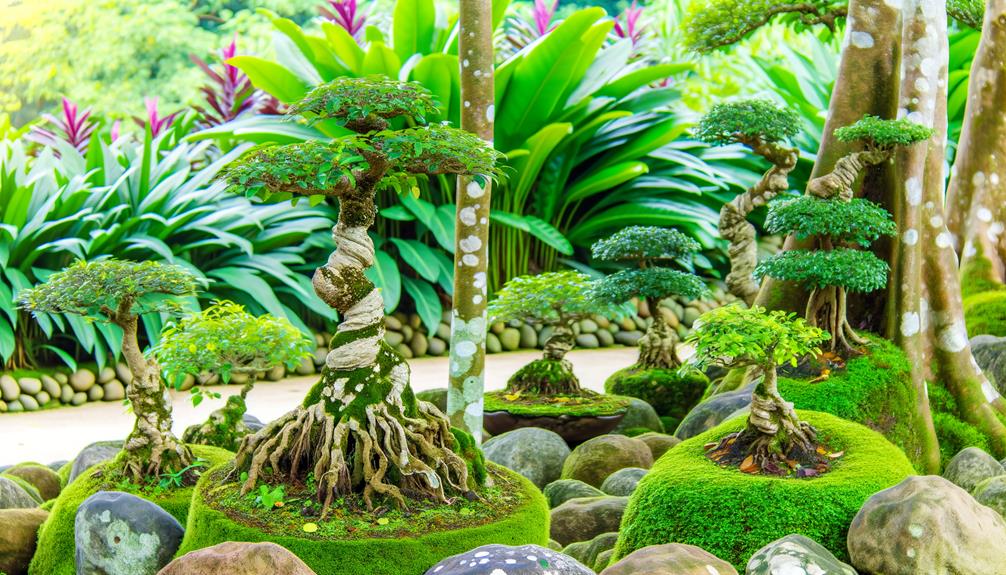Top 5 Common Bonsai Trees for the Philippine Climate
In the diverse climates of the Philippines, common bonsai trees include Ficus benjamina, Ficus microcarpa, and Ficus retusa, noted for their glossy leaves and aerial roots. Bougainvillea glabra and Bougainvillea spectabilis offer vibrant bracts and thorny stems.
Crassula ovata, also known as Philippine Jade, is favored for its succulent leaves and woody stems. Pterocarpus indicus, or Narra bonsai, stands out with its intricate roots and yellow flowers.
Pemphis acidula, known as Bantigue, thrives in saline environments with gnarled trunks. These species' adaptability makes them ideal for bonsai cultivation in the Philippines.
Deeper insights await for each species.

Key Takeaways
- Ficus species like Ficus benjamina, Ficus microcarpa, and Ficus retusa are popular due to their adaptability and striking forms.
- Bougainvillea varieties, including Bougainvillea glabra and Bougainvillea spectabilis, are favored for their vibrant bracts and resilient nature.
- Philippine Jade (Crassula ovata) is a common choice for its succulent leaves and minimal watering needs.
- Narra bonsai (Pterocarpus indicus) is admired for its broad leaves and vibrant yellow flowers, requiring meticulous care.
- Bantigue trees (Pemphis acidula) are ideal for coastal bonsai displays due to their resilience to saline environments.
Ficus Species

The Ficus species, including Ficus benjamina, Ficus microcarpa, and Ficus retusa, are prevalent choices for bonsai cultivation in the Philippines due to their adaptability and resilience.
Ficus benjamina, commonly known as the Weeping Fig, features glossy, ovate leaves and a dense canopy, making it aesthetically appealing.
Ficus microcarpa, also known as the Chinese Banyan, is characterized by its aerial roots and small, dark green leaves, ideal for intricate bonsai designs.
Ficus retusa, or the Banyan Fig, is favored for its robust trunk and broad, oval leaves.
These species exhibit remarkable tolerance to pruning and varying environmental conditions, enabling successful cultivation in diverse Philippine climates. Their rapid growth and ease of maintenance further enhance their popularity.
Bougainvillea Varieties
In addition to Ficus species, Bougainvillea varieties, such as Bougainvillea glabra and Bougainvillea spectabilis, offer vibrant and enduring options for bonsai enthusiasts in the Philippines.
Bougainvillea glabra, commonly known as paperflower, is characterized by its smooth, thorny stems and small, ovate leaves. Its bracts, often mistaken for flowers, exhibit vivid hues of magenta, purple, and red.
Bougainvillea spectabilis, on the other hand, presents larger, pubescent leaves and more robust thorns. This species' bracts are similarly vibrant, with a slightly broader color range.
Both varieties thrive in well-drained soil and require full sunlight to maintain their vivid coloration. Regular pruning is essential to manage their vigorous growth and to shape them into aesthetically pleasing forms.
Philippine Jade

Philippine Jade, scientifically known as Crassula ovata, is a popular bonsai species favored for its succulent leaves and thick, woody stems that can be expertly shaped into intricate and aesthetically pleasing forms.
This species thrives in well-draining soil and requires minimal watering, making it an ideal candidate for bonsai enthusiasts in the Philippines. The Crassula ovata is also known for its resilience to various climatic conditions, making it a robust option for both beginners and experienced bonsai practitioners.
Key features of Philippine Jade bonsai:
- Succulent Leaves: Thick, water-storing leaves that minimize the need for frequent watering.
- Woody Stems: Sturdy, lignified stems that provide structural integrity.
- Climatic Resilience: Adaptability to various environmental conditions, ensuring longevity.
Narra Bonsai
Renowned for its vibrant yellow flowers and durable hardwood, Pterocarpus indicus, commonly known as Narra, offers a unique and rewarding challenge for bonsai enthusiasts in the Philippines. Characterized by its intricate root structure and broad, pinnate leaves, Narra bonsai requires meticulous care. This species thrives in well-draining soil and needs moderate watering, while providing sufficient sunlight for peak growth.
| Feature | Description | Notes |
|---|---|---|
| Scientific Name | Pterocarpus indicus | Commonly known as Narra |
| Leaf Structure | Broad, pinnate leaves | Essential for photosynthesis |
| Flower Color | Vibrant yellow | Blooms seasonally |
| Soil Type | Well-draining | Prevents root rot and promotes health |
Bantigue Trees

How does *Pemphis acidula*, commonly known as Bantigue, captivate bonsai enthusiasts with its naturally gnarled trunk and resilience to harsh coastal conditions? This unique species thrives in saline environments, making it an ideal candidate for coastal bonsai displays. The tree's robust structure and intricate root system, coupled with its grayish-brown, weathered bark, provide a visually striking appearance.
To cultivate and maintain a Bantigue bonsai effectively, consider the following:
- Watering Regimen: Regularly water with salty water to mimic coastal conditions.
- Pruning Techniques: Employ careful pruning to enhance its natural, wind-swept look.
- Soil Composition: Utilize a well-draining soil mix with added sand to replicate its native, sandy habitat.
These guidelines guarantee a healthy and aesthetically pleasing Bantigue bonsai.
Conclusion
The diversity of bonsai species in the Philippines, including Ficus species, Bougainvillea varieties, Philippine Jade (Crassula ovata), Narra (Pterocarpus indicus), and Bantigue trees (Pemphis acidula), offers a profound reflection of the region's rich botanical heritage.
Despite concerns regarding the adaptability of these species to the bonsai technique, their successful cultivation demonstrates the resilience and versatility of these plants.
This adaptability underscores the potential for further exploration and innovation in the field of bonsai horticulture within tropical environments.






